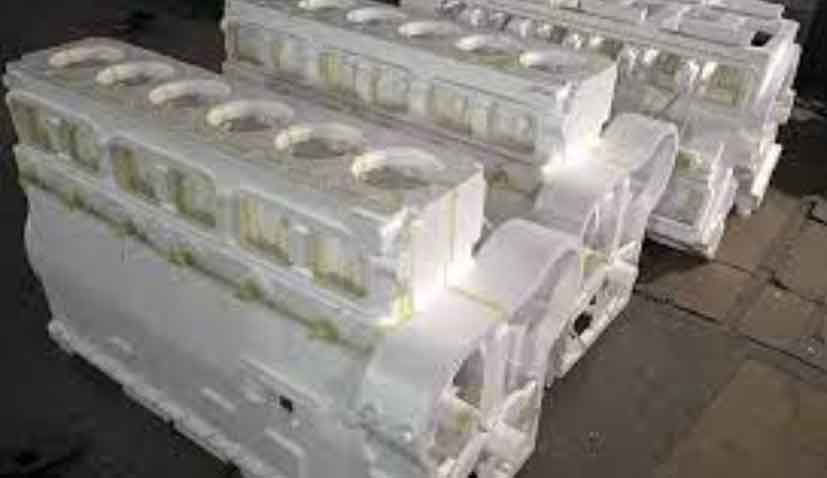Lost foam casting (LFC) has emerged as a near-net-shape manufacturing process that enables green production while maintaining high precision. This study examines its implementation in producing engine blocks for diesel and gasoline vehicles, focusing on material optimization, process parameters, and quality validation.
1. Technical Characteristics of Engine Block Castings
The HT250 low-alloy cast iron composition is critical for achieving required mechanical properties:
| Element | Range (%) | Impact on Properties |
|---|---|---|
| C | 3.10-3.30 | Controls graphitization |
| Si | 1.60-1.80 | Enhances fluidity |
| Mn | 0.60-0.75 | Improves hardenability |
| Cu | 0.6-1.0 | Strengthens matrix |
| Cr | 0.3-0.5 | Enhances wear resistance |
The target mechanical properties include tensile strength ≥250 MPa and hardness 187-255 HBS, achieved through controlled cooling and stress relief annealing at:
$$ T_{anneal} = 550^\circ C \pm 10^\circ C $$
2. Process Design and Implementation
2.1 Mold Design Optimization
Horizontal parting design with strategic cavity offsetting ensures proper demolding while maintaining dimensional accuracy. Key parameters include:
$$ \text{Pattern shrinkage} = \alpha_{EPS} + \alpha_{metal} + \alpha_{process} $$
Where αEPS = 0.3-0.5%, αmetal = 0-0.3%, and αprocess accounts for coating deformation.

2.2 Foam Pattern Production
Using B107 EPS beads, the expansion process follows:
$$ \rho_{final} = \frac{m_{pre-exp}}{V_{mold}} $$
Controlled parameters:
| Process Stage | Temperature (°C) | Duration |
|---|---|---|
| Pre-expansion | 105-110 | 90-120s |
| Maturation | 25-30 | 4-8h |
| Molding | 110-120 | 180-240s |
2.3 Coating System
The refractory coating formulation ensures gas permeability and thermal stability:
$$ \delta_{coating} = \frac{Q_{gas}}{A \cdot t} \cdot \sqrt{\frac{\mu}{P}} $$
Where Qgas = pyrolysis gas volume, μ = gas viscosity, P = vacuum pressure.
3. Gating System Design
The pressurized gating ratio (1.3-2):(1-1.5):1 ensures rapid filling:
$$ t_{fill} = \frac{W_{metal}}{\rho \cdot A_{choke} \cdot v} $$
Where Wmetal = 85-95 kg, Achoke = 12.8 cm², v = 0.8-1.2 m/s.
| Parameter | Value |
|---|---|
| Pouring temperature | 1480-1500°C |
| Vacuum pressure | -0.035 to -0.040 MPa |
| Solidification time | 90-110 min |
4. Quality Validation
The implementation results demonstrate process efficiency:
$$ \eta_{yield} = \frac{N_{good}}{N_{total}} \times 100\% = 95.2\% $$
$$ \eta_{machining} = 99.1\% $$
Key advantages of lost foam casting for engine blocks include:
- 45% reduction in post-processing costs
- 91% metal yield rate
- 30% energy saving compared to conventional sand casting
5. Process Optimization Strategies
Critical control points for lost foam casting success:
$$ \text{Quality Index} = \prod_{i=1}^{n} \left(1 – \frac{\sigma_i}{\mu_i}\right) $$
Where σ represents process variation in:
- Pattern density (23-24 g/L)
- Coating thickness (1.0-1.5 mm)
- Vibration intensity (40-60 Hz)
This comprehensive approach to lost foam casting implementation ensures sustainable production of high-performance engine components while addressing environmental concerns through reduced material waste and energy consumption.
